Design & Concept
Our Design
The garden is divided into 5 sections based on key changes that led to our modern Irish diet, reflecting archaeological and modern agricultural evidence for changing food preferences over time:
Section 1 ‘Early Settlers’ → Section 2 ‘First Farmers’ shows how the introduction of farming changed the original landscape with woods and lakes but no fields to a landscape where land was cleared for the first fields, pushing woodland to the field edges. Gathered foods were not abandoned, however, when farming was introduced to Ireland and they continued to play an important role in the diet.
Section 2 → Section 3 ‘Medieval Traders’ illustrates more prevalence of imported foods, displaying produce that was not grown in Ireland e.g. figs and grapes on tree stumps, alongside changing crops and other food preferences.
Section 3 → Section 4 ‘Industrial society’ – shows the introduction of mechanisation, transport and refrigeration, with very formal, organised fields in the landscape. This period introduced the possibility of widespread transportation of food and food storage through refrigeration.
Section 4 → Section 5 ‘Modern Day’ – illustrates globalisation in trade resulting from improved communication and transportation which has resulted in Ireland having unrestricted access to globally grown foods.
Each of the 5 sections contains a selection of key food plants related to the time period. Foods in the first section are grown amongst a variety of other wild plants, reflecting the lack of fields and landscapes from which food was procured. In the final section, food crops are strictly segregated into crop types in a highly organised field system and also includes imported foods. Moving from section 1 to section 5 illustrates the transition in the Irish diet.
Each section is divided at ground level by a water rill to show the critical importance of water, both in the human diet for hydration, and for plant growth. A small pond in the first section shows our early reliance on fish and depicts some unusual early foods e.g. the seeds of white and yellow water-lilies. After this time, the Irish shifted towards a more terrestrial-based diet, and marine and lacustrine resources remain a relatively small component of our diet today.
The 5 sections are also divided on the rear wall. Each section contains words explaining the time period e.g. Medieval Traders, along with high-quality images relating to that time. The images include reconstructions of archaeological sites excavated in advance of road construction projects by Transport Infrastructure Ireland.
Overall Design & Concept
This concept garden aims to visually display and explain the change in the Irish diet over the past 8,000 years from Early Settlers to Modern Day
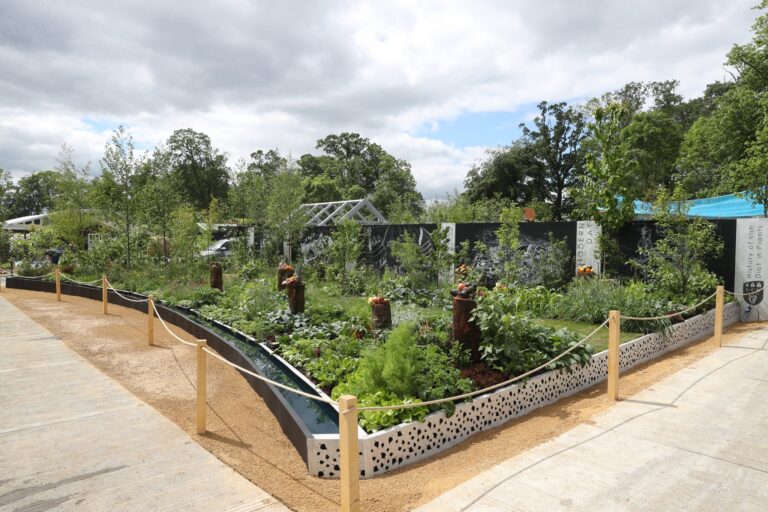
Garden Description
To produce excellent quality food crops requires well-managed, fertile soil with good drainage and adequate sunlight. However, the purpose of this garden is not to teach people how to grow food crops but instead to illustrate how the Irish diet has changed over time.
The garden is divided into 5 sections based on key processes that led to pronounced alterations in the Irish diet.
- Early Settlers
- First Farmers
- Medieval Traders
- Industrial Society
- Modern Day
Early Settlers

The earliest archaeological evidence for settlements in Ireland dates to the Mesolithic period, which began 10,000 years ago. Over the following four millennia, hunter-gatherers made use of many different environments to gather, hunt and fish for food. At the rear of this section, a person is shown fishing at Clowanstown, Co. Meath, where Mesolithic lakeside wooden platforms and fish baskets were uncovered by archaeologists in advance of construction of the M3 motorway (Illustrator: J.G. O’Donoghue; image courtesy of Transport Infrastructure Ireland).
FEATURED PLANT IN FIRST SECTION
Seeds of Nuphar lutea (L.) Sm. (yellow water-lily) have been recorded at archaeological excavations of Mesolithic sites in Ireland. The seeds are preserved because they were buried in wet conditions (waterlogged) or burnt (charred), which enables fragile plant material to survive for thousands of years. Ethnographic studies of indigenous peoples in North America show how water-lily seeds are prepared for consumption. Capsules are gathered and fermented in water, followed by cleaning of the seed, dehusking, winnowing, parching, grinding and then roasting. The process takes a minimum of two weeks. Alternatively, the seeds can be fried in fat to make a kind of popcorn, used as an insect repellent or used in dyeing.
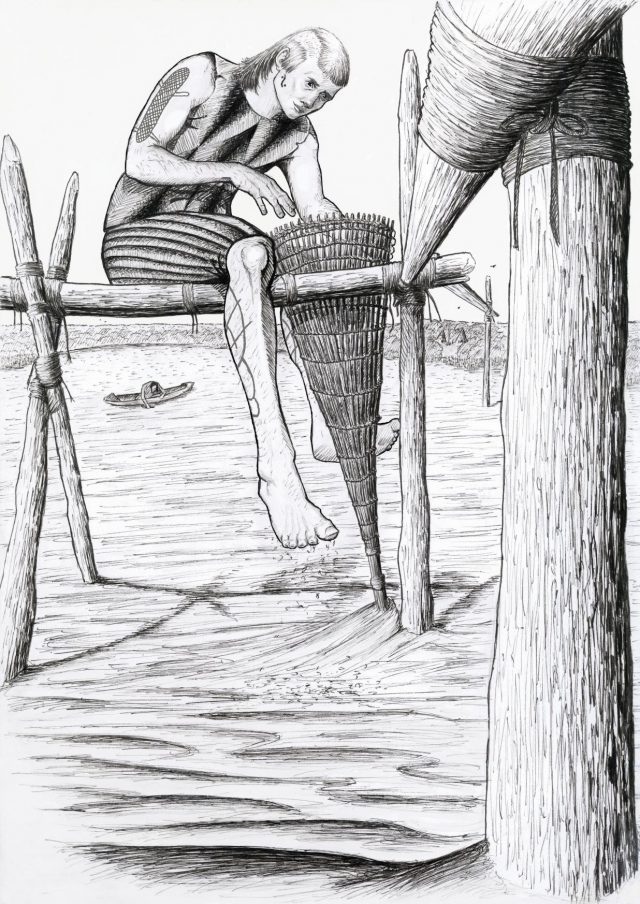
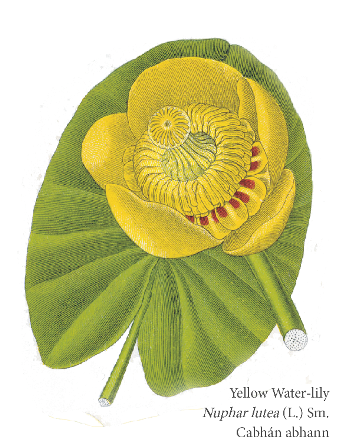
First Farmers

The earliest archaeological evidence for farming in Ireland dates to almost 6000 years ago, in the first centuries of the Neolithic period. New crops and animals arrived into Ireland, including Triticum spp. (wheat) and Hordeum spp. (barley), as well as cattle, sheep and pig. At the rear of this section, an Early Neolithic settlement at Town Parks, Co. Meath, is shown, consisting of a substantial rectangular house that was uncovered by archaeologists in advance of construction of the M3 motorway (Illustrator: Dan Tietzsch- Tyler; image courtesy of Transport Infrastructure Ireland).
FEATURED PLANT IN SECOND SECTION
Grains and chaff of Triticum dicoccon Schrank (emmer wheat) have been recorded at many archaeological excavations of Neolithic sites in Ireland. Emmer wheat is closely related to modern bread wheat, but emmer has a slightly different structure because it is a hulled wheat, which means it has strong husks that enclose the grain. Emmer wheat grains can be ground into flour for bread, boiled in porridges and stews, and malted to make ale, providing a taste similar to bread wheat but nuttier.
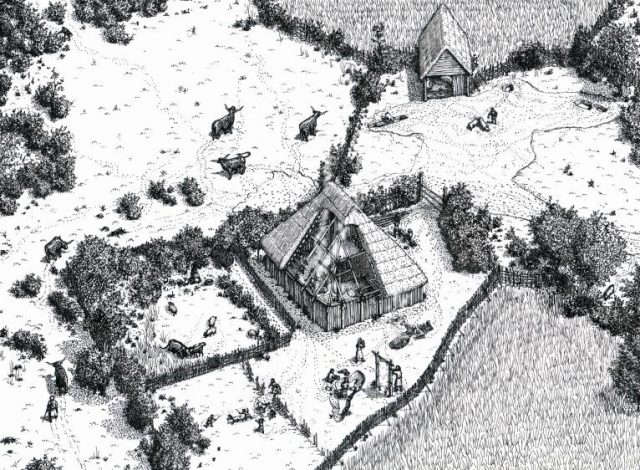
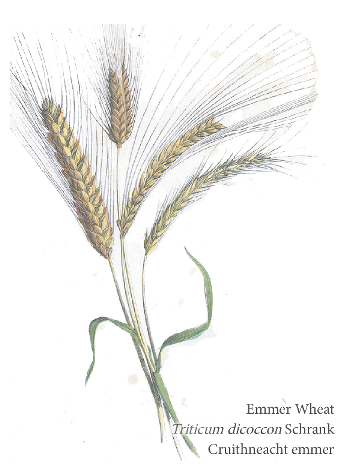
Medieval Traders

The medieval period in Ireland began in the 12th century, and although there is archaeological evidence for people trading foods before this time, there is a huge increase in trading during the medieval period. Foods were exported from and imported into Ireland; the latter included ‘exotic’ foods such as figs and walnuts. At the rear of this section, a medieval farmstead at Mondaniel, Co. Cork, is shown, consisting of a house and fields uncovered by archaeologists in advance of construction of the M8 motorway (Illustrator: Michael Duffy; image courtesy of Transport Infrastructure Ireland).
FEATURED PLANT IN THIRD SECTION
While cultivated foods were important, wild foods remained a key element of people’s diets in medieval Ireland. Seeds of Chenopodium album L. (fat-hen) are often found at archaeological excavations of medieval sites. Many gardeners now consider fat-hen to be a troublesome weed, but this was a useful food in the past. Its leaves were sold by hawkers as a vegetable, similar to spinach, until the 18th century in Dublin. The seeds of fat-hen can also be eaten, much like its better known relative, Chenopodium quinoa Willd. (quinoa).
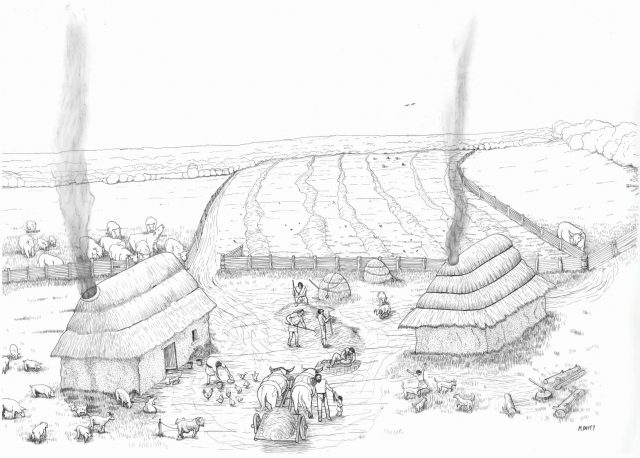
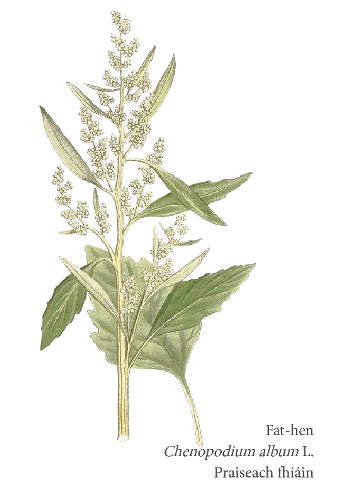
Industrial Society

Increasing industrialisation and urbanisation had profound effects on food in Ireland over the past few centuries. During the early 19th century, agriculture was the mainstay of the Irish economy. Although there was an extensive export trade, most crops and animals produced in Ireland were consumed here. Some sectors of society also made use of imported luxury foods. At the rear of this section, an early 19th-century cluster of houses and farm buildings at Moyveela, Co. Galway, are shown, uncovered by archaeologists in advance of construction of the N18 roadway (Illustrator: Dan Tietzsch- Tyler; image courtesy of Transport Infrastructure Ireland).
FEATURED PLANT IN FOURTH SECTION
Potatoes (Solanum tuberosum L.) were a key food for many people in early-19th century Ireland. Much land was given over to the growing of different varieties of potatoes to support a rapidly expanding population, with smallholders playing an important role in production. Archaeological evidence for potatoes is rather limited because such tubers do not tend to become preserved. Innovative scientific techniques, such as starch-granule analysis, are providing new pathways, however, to understanding the role of this iconic food in Ireland’s past.
Soon after the period depicted in Section 4 (200 years ago), the Great Famine occurred in Ireland, decimating the potato crop and resulting in starvation, disease and emigration for many citizens.
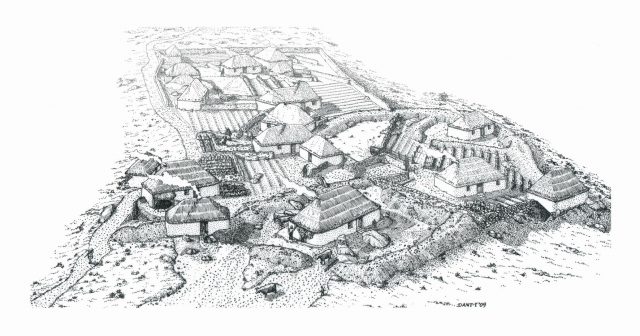
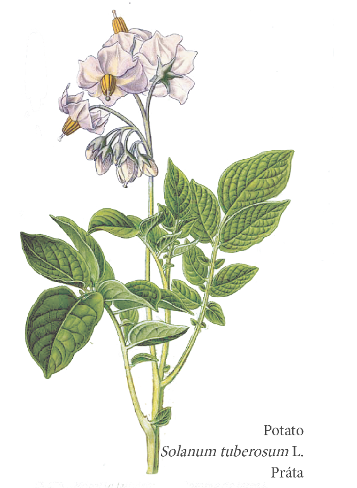
Modern Day

Nowadays, citizens of Ireland can access an enormous variety of foods, some of which are home-grown and many more imported. At the rear of this section, a modern-day scene in a supermarket is shown, reflecting the key role that large food retailers now play in many people’s lives (Illustrator: John McCord). At this time of increasing consumption and more diverse cuisines, the development of sustainable production and consumption practices has become an important goal for many stakeholders in the Irish food industry.
FEATURED PLANT IN FIFTH SECTION
Chilli peppers belong to the Capsicum (pepper) genus, and they reflect our shift towards a more globalised diet. While chilli peppers can be grown indoors in Ireland, most are imported. Archaeological evidence indicates that domestication of various Capsicum species occurred in different locations around Central America, South America and the Caribbean, with some species domesticated at least 6000 years ago by indigenous peoples.
In recent decades, increased travel, both into and out of Ireland, has dramatically influenced and broadened food preferences. The modern Irish diet is now a combination of Irish produced foods and imported exotics.
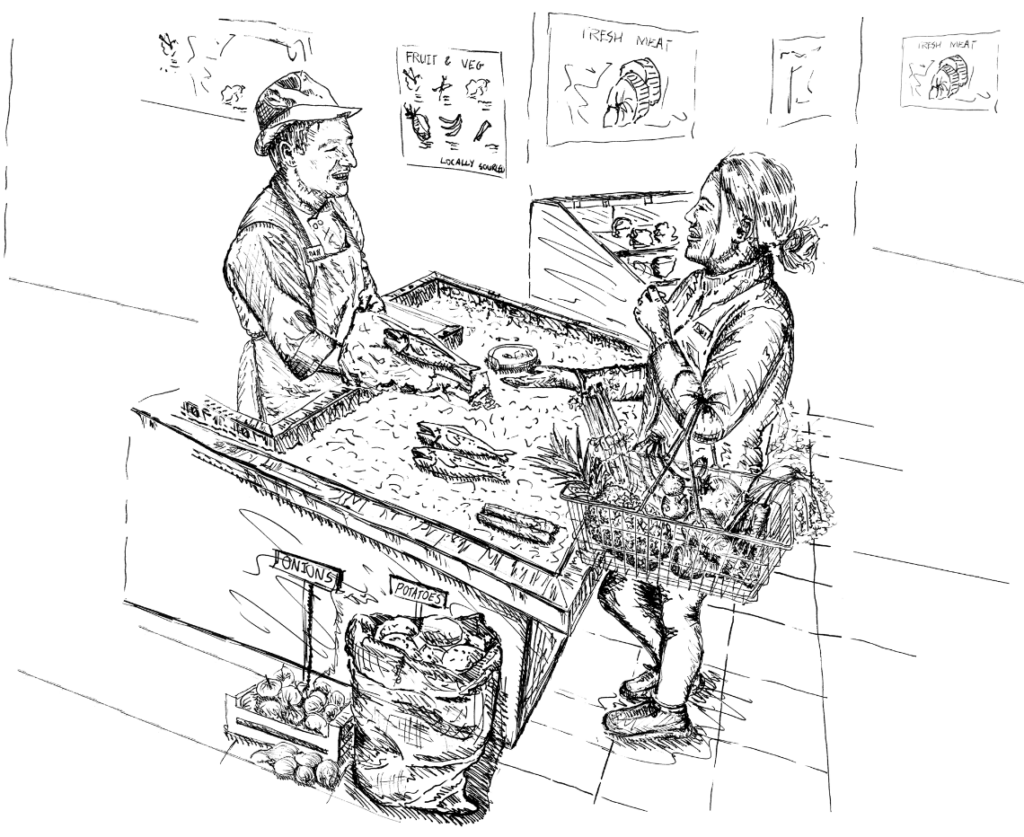
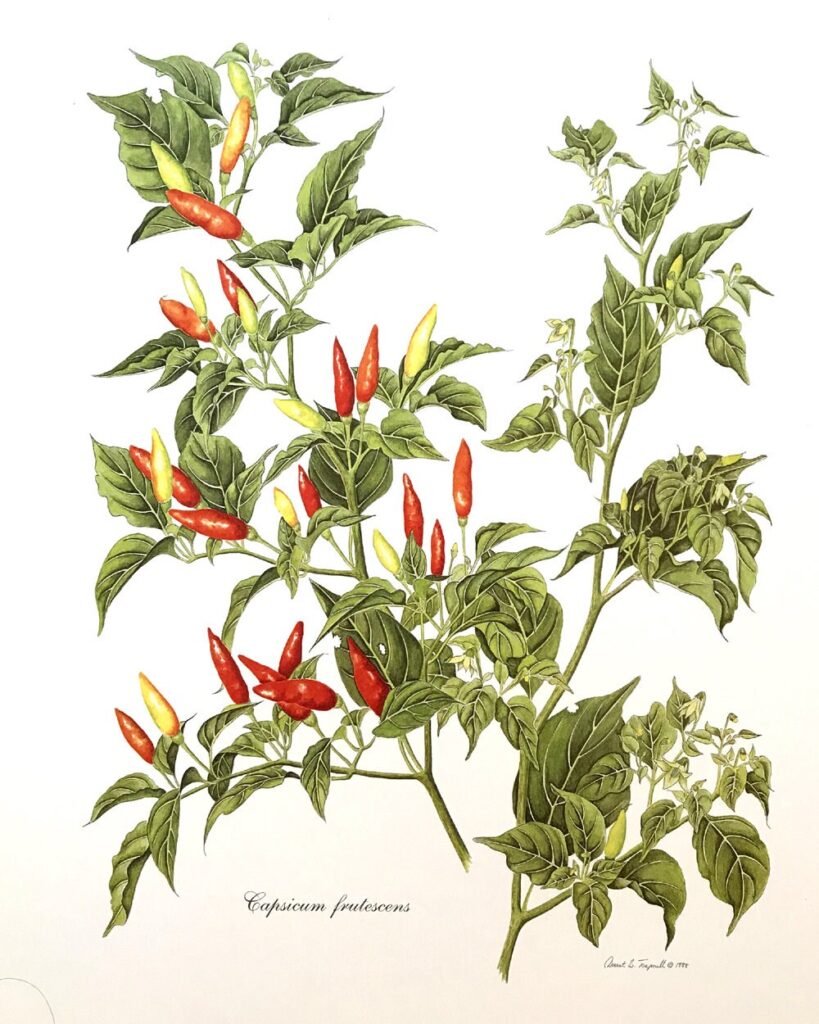
Plants
The plants displayed in the UCD History of the Irish Diet in Plants garden visually illustrate changes in the Irish diet over the past 8000 years.
The garden is divided into five distinct sections: Early Settlers; First Farmers; Medieval Traders; Industrial Society and Modern Day, with each section representing a time period that led to dramatic changes in our diet and reflects archaeological and modern agricultural evidence for changing food preferences.
Each section within the garden is divided by a metal rill and displays key food plants related to the time period. The chosen plants reflect evidence from archaeological excavations and historical records, which highlight changing food choices in Ireland over several millennia.
Each of the five sections has one featured plant along with a number of the plants listed below:
Featured Plants
Each of the five sections has one featured plant which is highlighted below.
Early Settlers

Name: Yellow Water-lily
Description: Seeds of Nuphar lutea (L.) Sm. (yellow water-lily) have been recorded at archaeological excavations of Mesolithic sites in Ireland. The seeds are preserved because they were buried in wet conditions (waterlogged) or burnt (charred), which enables fragile plant material to survive for thousands of years.
First Farmers

Name: Emmer Wheat
Description: Grains and chaff of Triticum dicoccon Schrank (emmer wheat) have been recorded at many archaeological excavations of Neolithic sites in Ireland.
Medieval Traders

Name: Fat-hen
Description: While cultivated foods were important, wild foods remained a key element of people’s diets in medieval Ireland. Seeds of Chenopodium album L. (fat-hen) are often found at archaeological excavations of medieval sites.
Industrialisation

Name: Potato
Description: Potatoes (Solanum tuberosum L.) were a key food for many people in early-19th century Ireland. Much land was given over to the growing of different varieties of potatoes to support a rapidly expanding population, with smallholders playing an important role in production.
Modern Day
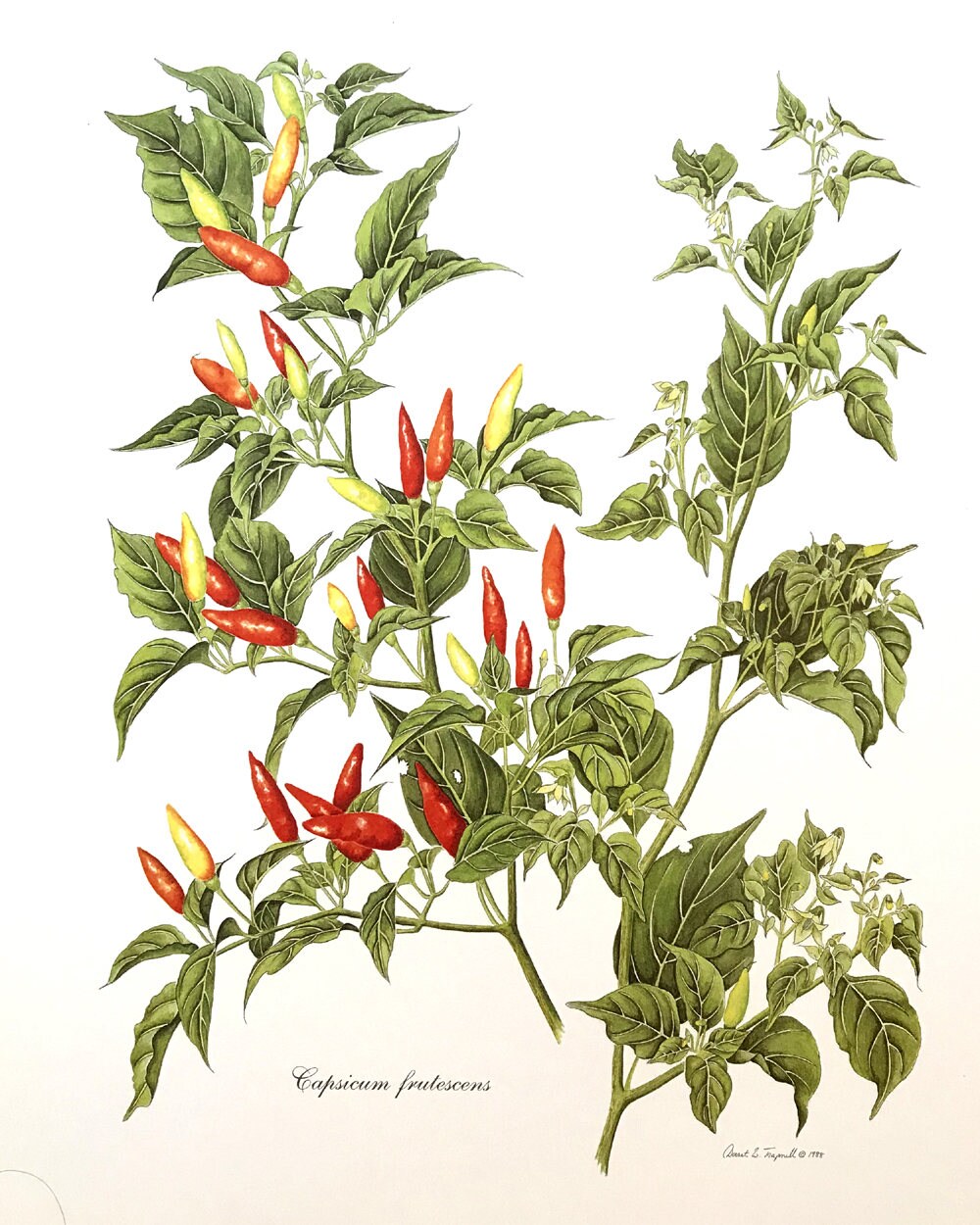
Name: Chilli
Description: Chilli peppers belong to the Capsicum (pepper) genus, and they reflect our shift towards a more globalised diet. While chilli peppers can be grown indoors in Ireland, most are imported.